Facility management and the smart building in evolution: the changing reality of smart buildings in an increasingly connected day and age.
Smart buildings are among the main areas of applications for IoT (Internet of Things) and related technologies that unlock its value for years to come. Yet, the smart building can take many forms and shapes and smart buildings are not just about technologies, let alone about the IoT.

Moreover, as opposed to what one might imagine in these days where smart often refers to a mix of IoT, advanced analytics, artificial intelligence and machine learning, a bit of autonomous decisions in buildings, edge computing and so forth, the smart building is one of the few exceptions and exists since long before IoT and modern-day IT.
According to 60% of facility managers IoT will impact building and maintenance policies within the next year
Obviously de facto IoT and several IT technologies are essential in smart buildings these days, yet the term smart building, its definition, its many aspects, smart building technologies and standards etc. exist since long before anyone even coined the term Internet of Things.
Smart buildings in a perspective of time
Smart buildings, which among others used to be called intelligent buildings, as in intelligent building management (and still are but in recent years there has been a clear change in terminology preference) go back to times Google didn’t exist yet.
There are ample so-called ASHRAE transactions, for instance, from the late eighties where you can already find these terms (ASHREA is short for American Society of Heating, Refrigerating and Air-Conditioning Engineers, which de facto is a global organization). Both terms intelligent building and smart building in other words exist since certainly three decades but of course evolved over time.
Just to put that in perspective for younger readers: Google was founded late 1998, you can find back ASHRAE conference proceedings and transactions regarding intelligent buildings since the second half of the eighties and on smart buildings a few years later.
ASHRAE was founded in 1894 by the way but then there was no intelligent or smart building around indeed. The majority of publications with novel approaches in areas such as energy management, HVAC and other areas which still matter in the overall intelligent and smart building perspective really took off in the seventies. It does put things in perspective.
Facility management as a discipline isn’t exactly new either. However, here as well many changes, including technological ones, have taken place.
Taking into account the evolutions of the meaning of the terms smart buildings and facility management (it’s definitely not primarily about technology), both are increasingly seen in a context of IoT, the integration of IT and OT (Operational Technology), big data analytics, cloud, AI and all these so-called third platform technologies and their several innovation accelerators that drive digital transformation and also change the meaning and face of intelligent and smart buildings, giving direction to their evolutions with equally changing human and societal challenges.
Time for a look at smart buildings and facility management in the scope of real estate, smart cities, the construction industry or AEC industry, and the built environment overall, today and tomorrow.
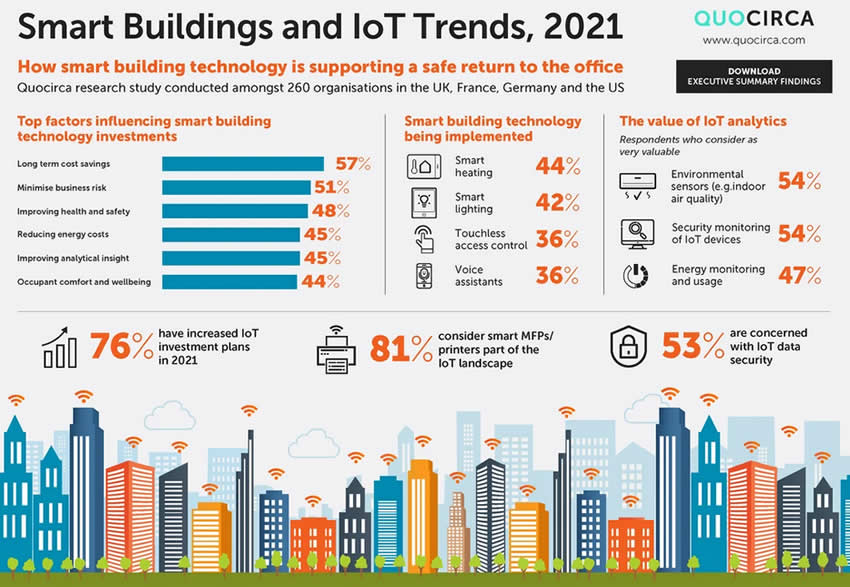
Smart facility management in the people, place, process and connected technology perspective of the smart building
Let’s start by telling you we love buildings. That’s not a joke. Have you ever considered what the possibility to live, work, sleep and whatnot in a building has really meant in the evolution of mankind?
And we mean buildings in the broadest possible sense, including factories, hotels, airports, houses and all the activity that is going on in them. Heating, ventilation, elevators, cooling, security, lighting, an endless list. Most of us are born in a building and spend plenty of key events in our lives in buildings: good moments, bad moments and those extraordinary moments we’ll never forget.
How much time do you spend inside buildings? Think about your home, hotels, the places where you work, go to have fun or do business and more. Indeed: a lot!
The IoT market for intelligent buildings will exceed $22Bn in 2026
Even if you exclude the place where you live and call home, you spend ample time in buildings and other facilities. While making your home a safe and agreeable place for you and your loved ones is primarily a matter of your personal preferences, choices and improvements, possibly with the help of experts such as architects or interior designers, one of the many tasks of facility management is to do the same for all the other types of buildings out there.
Smart buildings today: driven by a mix of technologies and evolving demands
We often don’t realize it, unless of course we’re facility managers, but there are many tasks, processes and efforts going into making the buildings you work in, visit or stay in while traveling, safe, agreeable, efficient (in the sense of ecology, costs and so forth) and, increasingly, ‘smart’.
While there is a lot of focus on the the smart ‘commercial building’, the residential smart building, known as the smart home is poised to become a key driver in the Internet of Things (IoT) market as well (it already leads in the main area of IoT investment).
The top reasons for investing in smart building technology are cutting long-term costs (57%), reducing risk (51%) and improving health and safety (48%).
Smart buildings as a cross-industry IoT use case
From that same IoT perspective the smart building space is one of those typical cross-industry markets with tremendous opportunities and evolutions in, among others building management systems, light and room control or critical power for specific types of buildings (more about building management in the age of IP and IoT).
With smart buildings, an increasingly important topic in facility management, we are in a far more complex environment than that of the home. At the same time it’s also a far more important one, at least from a broader societal perspective and depending on the function of the building.
While your home is probably much more important to you than, let’s say, an office building or a hotel, the impact of all the buildings out there from an energy and ecology perspective alone is huge. This is even more the case if we know that the population in cities is poised to significantly grow, which means more pressure on cities, public buildings and of course a rise of new housing complexes and infrastructural needs. The latter are just some of the many aspects of smart city initiatives and smart cities in evolution overall.
The IoT market in commercial buildings: over $22 Billion in 2026
The growing importance of IoT for smart buildings is emphasized in a Summer 2017 report by Navigant Research.
The company estimates that the worldwide IoT market for intelligent buildings will exceed $22 Billion in 2026. By way of comparison, for the current year 2017, Navigant Research sees a global IoT for intelligent buildings market of $6.3 billion in 2017.
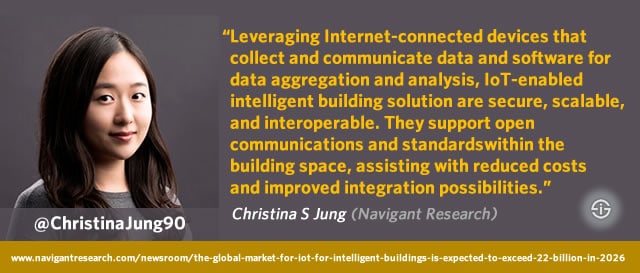
Navigant Research looks at the total IoT market in commercial smart buildings. In other words: all hardware, software and services, including for instance building energy management systems (BEMS) or energy management systems (EMS), if you prefer. As mentioned in our BMS evolutions overview’s terminology section, a BEMS/EMS is not a building management system or BMS and that’s indeed what the other report has been looking at.
This being said and leaving the precise meaning of the intelligent building aside let’s take a look at some of the main drivers of the growth of IoT for intelligent buildings forecasts as summed up in the press release from Navigant.
IoT in smart buildings: the multiple drivers of increasing adoption and spending
Not too many surprises on that level but important to remind some key drivers of growing IoT adoption and spending for smart buildings:
- The pressure of building owners (so,in this case commercial building owners) to invest in intelligent building technologies which leverage the IoT.
- Within the scope of that pressure the need of building owners to get better insight on building operations and on equipment. Do think maintenance and asset management, efficiency, cost savings, key insights for actions to take and of course the increasing expectations of the occupants of commercial buildings.
- In that context of “the customer of the customer of the customer” think about the clients of commercial building owners such as organizations who are not just looking to leverage IoT and intelligent solutions for myriad reasons themselves but also want to be in buildings where operations are optimal and need to be able to say that they are housed in efficient and ecology-friendly state-of-the-art buildings (pressure of clients, pressure of peers included). Moreover, these organizations have customers too, with workers being important internal customers who also have their expectations.
- Also within the scope of the pressure of building owners and closely related to the others we note the need to access “real-time data for productivity, convenience, and sustainability”. That pretty much speaks for itself: productivity for all stakeholders (including the staff of the customer), same for comfort and, let’s not forget, regulations and cost control and in and beyond that scope the higher importance of energy efficiency which is driving BMS evolutions as well. And of course there is a premium for those owners who offer it all.
- The evolutions in the markets of the involved technologies whereby, just as is the case with the acceleration of IoT overall, declining prices (here in hardware), in combination with increased storage and computing power boost adoption – and thus by definition also spending of IoT in intelligent buildings. Cloud computing is mentioned as key here.
- The benefits of IoT in intelligent buildings. It wouldn’t of course make much sense to invest in IoT for intelligent buildings just because of computing and storage power or declining costs nor because of building owner pressure (although that is a big and complex one). On top of benefits with regards to operations, maintenance, building value, the results of enhanced energy management and so forth Navigant also mentions revenue generation services – and that is still all too often forgotten, not just in buildings but with regards to IoT monetization and the development of new services and sources of revenues overall. It doesn’t even need to be THAT hard, with for instance facility management services or by combining data from several buildings and leverage it in novel ways to whomever can use the derived insights (just as telcos do).
Quoting Navigant research analyst Christina Jung: “Leveraging Internet-connected devices that collect and communicate data and software for data aggregation and analysis, IoT-enabled intelligent building solutions are secure, scalable, and interoperable. They support open communications and standards within the building space, assisting with reduced costs and improved integration possibilities”.
Facility management is by definition an information-intensive and connected data reality
Just as, in the end, smart buildings and smart cities, are about people, processes, technologies (connected data as enabled by, among others the IoT) and mobility (moving from place to place), facility management is traditionally defined from a more or less similar perspective.
As the international association for facility management professionals, IFMA, puts it, facility management is a profession that encompasses multiple disciplines to ensure functionality of the built environment by integrating people, place, process and technology.
If you are familiar with the Internet of Everything and with information management, you’ll find those terms back in their definitions – and objectives – too. And that is of course not a coincidence so it won’t come as a surprise that the Internet of Things, leveraging actionable intelligence which are derived from data (what information management, data analytics and in this scope are about) and newer technologies are having a major impact in facility management.
It’s important to remember that facility management, green buildings and the usage of technologies in buildings obviously aren’t obviously new. To become a facility manager you need a degree for a reason as there are so many aspects and also many components.
Just think how elevators, building security systems, Heating, ventilation and air conditioning (HVAC), predictive maintenance, asset management, building automation systems and so forth are all technology-intensive. On top of these hard services, soft services are affected by emerging technologies as well. IoT and related technologies further lead to a rise of integrated facility management services.
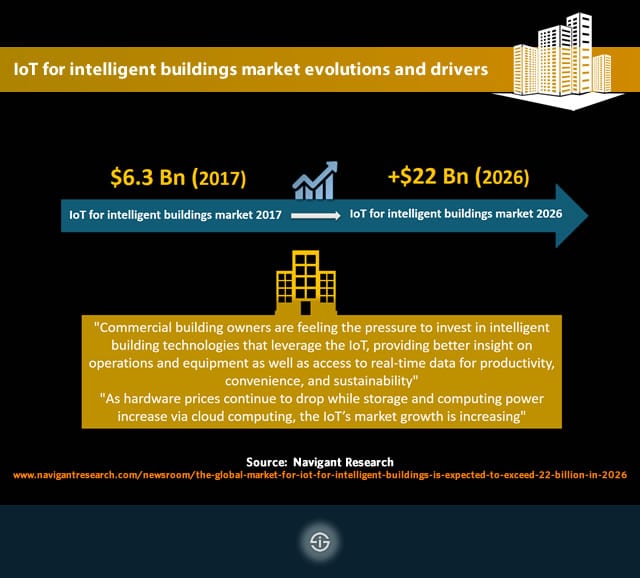
The difference of IoT in the smart building: bridging silos in the integration of IT and OT for smart facility management use cases
What is mainly changing in smart buildings with the Internet of Things is that thanks to the possibilities that arise from a smart integration of IT and OT myriad new opportunities arise.
That IT and OT integration is also one of several reasons why the (industrial) Internet of Things has been rising fast, certainly in areas such as manufacturing, the largest IoT sector from a spending perspective.
Whereas various systems to optimize and maintain buildings, facilities and their various assets used to – and still often do – live in perfect isolation, the trend is clearly one of integration with IoT as a key factor.
We also see this in another area that is increasingly important in the digital transformation of the construction industry: BIM (building information modeling and management). Integrations between BIM, IoT, augmented reality, various construction and operations platforms, and digital twins, to name some, are on the rise with the role of BIM expanding way beyond its original scope and ample innovation happening.
Last but not least, a whole range of applications is becoming increasingly important with the pandemic. Space management is just one example.
The benefits of smart buildings for facility management and customers – correlations with the scope of the facility
The IoT use cases in smart buildings and facility management as said differ, depending on the scope of the building/facility. This also defines the many benefits of smart buildings.
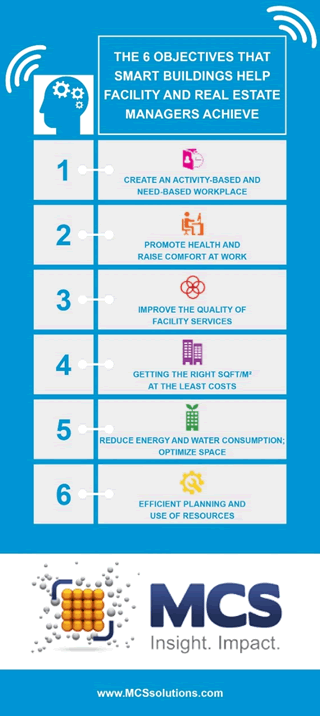
As an example: among the goals in the scope an office building we need to make sure that workers feel well, are safe and can do their jobs in an agreeable setting, while not breaking the bank – and reducing costs – from an energy consumption perspective.
In hotels you might find more use cases that focus even stronger on the guest experience and, for example, make sure that during the night, when external noises are often heard more, you want your guests to sleep in a noise-free environment. Sure, workers don’t want too much external noise either but during the day that’s a different story – and an office building is not really designed for people to fall asleep.
Now, if you think about the needs of a hospital building or a data center, to name two more examples, you can image that facility management is again another priority ballgame.
The people of integrated real estate, facility and workplace management company MCS summarized some benefits of smart buildings for facility managers in an infographic, depicted above, citing the following six benefits:
- The possibility to create an activity-based and need-based workplace.
- The potential to enhance health, comfort (and let’s say general conditions) at work.
- An ability to improve the quality of facility services overall.
- Getting the right SQFT/M² at the least costs.
- In the same cost (but also ecology and green building) perspective: the ability to optimize space and reduce consumption of energy and water.
- Having means for a more efficient planning and use of resources.
Keeping in mind what we wrote about some examples of facilities with different purposes (data centers, hotels, hospitals etc.) you can certainly add more smart building benefits, both for facility management pros and for workers, patients, guests, customers, you name it.
A smart building needs smart energy management and smart energy technologies
You can look up the website of any player in smart buildings or building automation systems, whether it’s for smart home automation, large commercial buildings, critical power buildings or anything in-between: energy efficiency, energy savings and changing expectations of all stakeholders in the broadest possible smart building context (regulators, building owners, tenants, facility managers, you name it) are putting smarter energy monitoring, smarter energy solutions and smart energy management high on the list of smart building priorities. It showed in the mentioned research, and in fact all research regarding building and facility management evolutions, as well.
Of course, other smart building goals are key too, depending on the purpose of the tenant/resident who in the end drives demand. Comfort, the disposal of intelligent technologies for smart working environments and all the rest we mentioned.
However, there is no doubt that in this day and age literally anything with regards to energy is crucial. Smart buildings do need smart energy management. Whether it’s through smaller energy management solutions for smaller buildings, smart home applications (where energy savings, insights and management are key as well), or in the field of BEMS (Building Energy Management System) solutions: myriad requirements regarding energy are often not just front and center (also in the BMS market) but energy efficiency is also present across virtually all areas of the smart building, whether it’s HVAC, room control, smart elevators and whatnot.
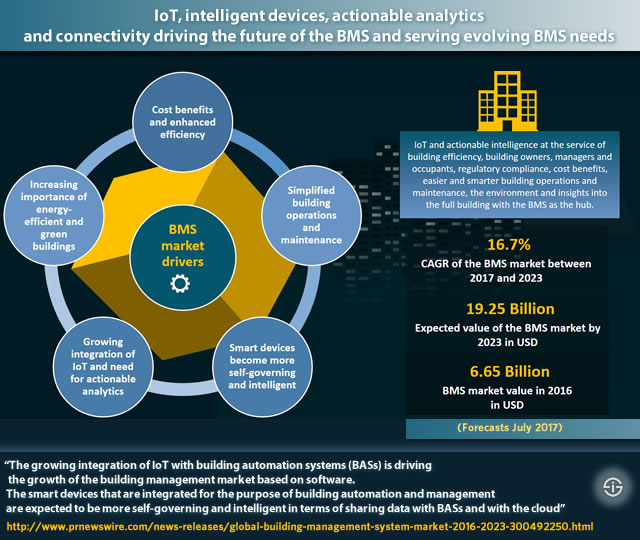
Just check the findings below from various research announced end 2017 on how smart building system and technology demands are driven by smart energy demands and regulations as well as by the typical technological integrations seen in the scope of the smart building.
- Among the main drivers of the BMS market itself for 2018 and beyond: growing demand for energy-efficient and eco-friendly buildings, with the increasing integration of IoT and all the technologies it comes with to realize intelligent, smart building environments as a key driver.
- In Europe alone (the whole of Europe that is), energy efficient building technologies are poised to significantly grow with a focus on the commitment to energy- and emissions-related goals in Western Europe. Smart, or if you prefer, intelligent building technologies and especially the advancements in these technologies and integrated ecosystems they shape are key in it all, also in Eastern Europe where other energy priorities for now are more important.
- Now that we’re in Europe, just take a look at all the smart building elements in the revised Energy Performance of Buildings Directive (EPBD): smarter ways to monitor energy performance and air quality conditions are part of the package for all buildings as are incentives to renovate, obviously with smart energy building applications in mind.
- The market of Building Energy Management Systems is not just driven by an increasing awareness of the value of data with regards to energy and buildings overall (and that value of course has to do with energy as well); the technological drivers of the BEMS market are the same smart building technologies we meet everywhere: IoT, cloud and edge computing, in other words with a focus on intelligence and analytics. And soon you can add artificial intelligence to that as we already see here and there in the movement towards more autonomous decisions, a key aspect of the smart building to begin with, just as autonomous decisions are central in Industry 4.0 and Logistics 4.0 where they are part of the, indeed smart, factory and supply chain vision.
You can go on for a while but the picture is pretty clear: no smart energy solutions, smart energy approach across all building components and smart energy management, no smart buildings.
And the exact same thing goes for the integration of not just connected technologies but also the integration of building systems and of more advanced energy-related measures with smarter energy being key in smart buildings.
According to the 2017 Johnson Controls Energy Efficiency Indicator survey, the integration of building systems, which is essential in smart buildings ranks high on the priority list of facility and management executives.
As the October 2017 press release states smart buildings continue to gain momentum with 46 percent of respondents already having invested in building systems integration last year and more than 80 percent of organizations planning to do so in the future. Among the main building systems already integrated in the smart building are energy management systems, lighting systems, security systems and life safety systems.
Moreover smart, sustainable buildings which are served by distributed energy resources and energy storage can provide the added security that building owners are looking for around the globe says the company’s Rod Rushing. As you can see in the PDF here, 57 percent of respondents plans to invest in onsite renewable energy in 2018 and 48 percent plans investing in electric storage.
Digital transformation in facility management: a major role for smart buildings and big data analytics
Just like in virtually all professional activities and industries, there is a digital transformation sweeping through facility management and as seen the Internet of Things, plays an important role in it from a technology and purpose (people, place, safety, process, automation, insights and action, efficiency,…..) perspective. However, IoT doesn’t stand on its own of course. Data collection, intelligence and, ultimately human, semi-autnonomous and autonomous decisions are what we are seeking.
Smart buildings: IoT, data and actionable intelligence
When 451 Research announced its first Voice of the Enterprise: Internet of Things (IoT) quarterly study (PDF opens), the company found that ‘buildings and other structures’ (such as HVAC) ranked fifth in the list of equipment, devices or other connected endpoints where most data or information gets gathered from.
Put in perspective: that’s more than environmental sensors, factory equipment, automobiles and fleet equipment and even retail, medical devices and devices in the supply chain.
In its forecasts regarding IoT spending 2017-2020, IDC mentioned smart buildings, along with connected vehicles, as one of the use cases which are poised to grow in the fast rising cross-industry IoT applications.
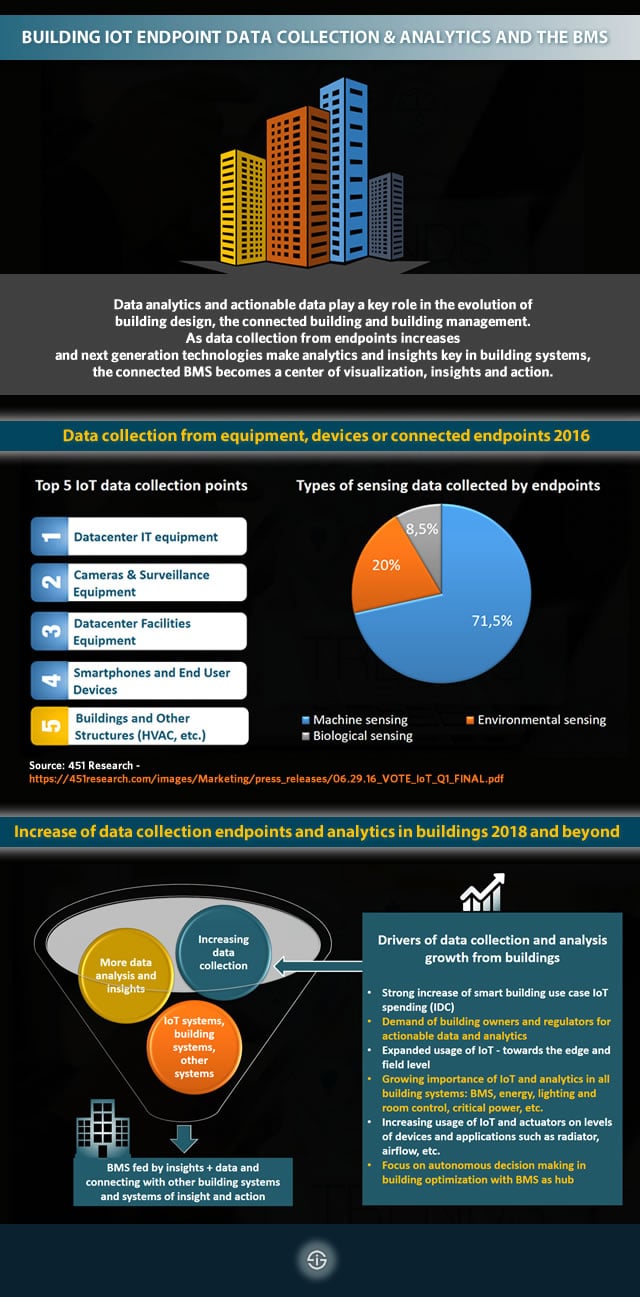
Facility management and the rise of IoT (research)
It’s clear that the Internet of Things and (big data) analytics profoundly impacts the smart buildings space and also facilities management.
That’s also what Schneider Electric, one of the large players in the BMS and energy management space, found in its Facilities Management Survey, released in May 2016. The infographic below (larger version in PDF) shows how the rise of IoT is prompting facility management professionals to invest in analytics.
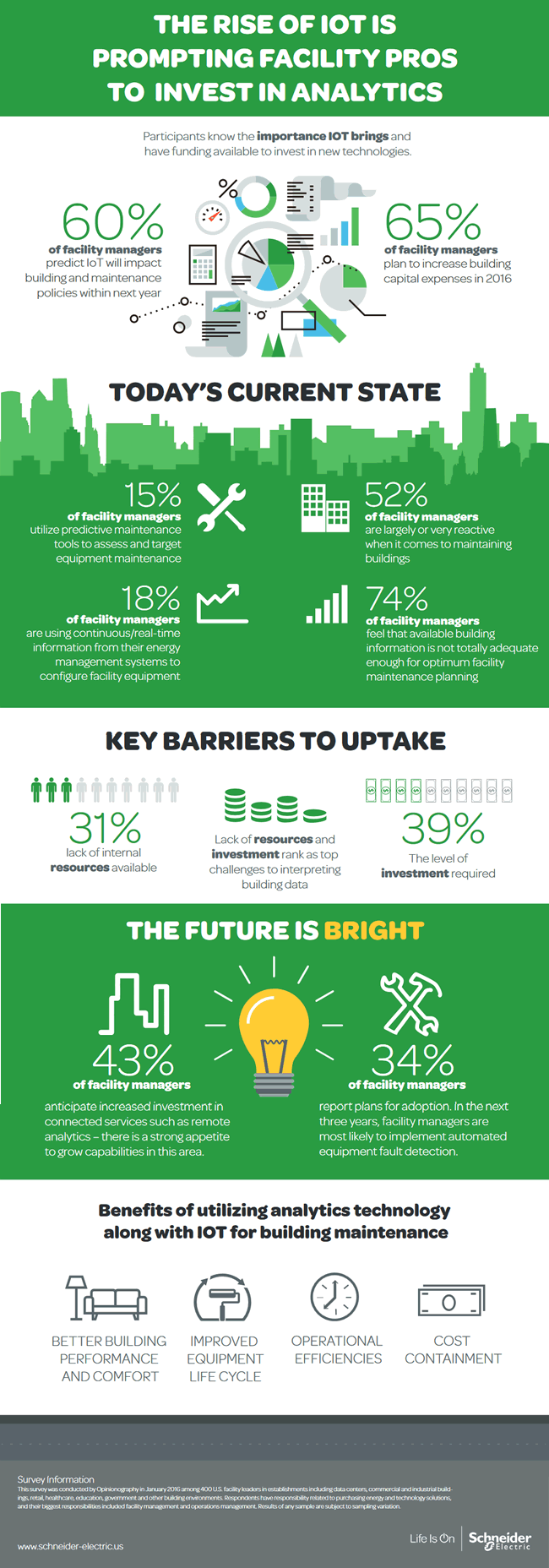
Among the highlights of the facility management survey:
- According to 60 percent of participating facility managers IoT will impact building and maintenance policies within the next year.
- Remote analytics (43 percent of facility management pros) is among the key areas of investment.
- More than a third (33 percent) today already has a proactive preventive maintenance on equipment.
More data in the SlideShare presentation.
From facility management to facility optimization management
The overall convergence in facility management, building management, building energy management and other facility management or building- and energy-related platforms is playing on several levels at the same time.
While, as said, some see an important role for the building management system as becoming the hub of connectivity in an end-to-end approach with a focus on all assets in the facility and all the stakeholders in a building ecosystem, similar evolutions happen on the side of building energy management systems.
The keyword in this scope is facility optimization and of course it is also related with IoT, convergence a focus on asset performance in a broader perspective and the experiences and values of all stakeholders.
Facility optimization of course isn’t new. Yet, what is new is that there is a new breed of facility optimization solutions that doesn’t just further remove the silos in facility management but also stands for a change in philosophy.
In July 2017, research firm Verdantix announced that it had identified 20 new technology firms as smart innovators in the Facility Optimization Management market according to its report, “Smart Innovators: Facility Optimization Management”. If you search for “Facility Optimization” on Google you will only find back Verdantix in the first search results.
Yet, while the term might be new, the underlying evolutions aren’t. As Rodolphe d’Arjuzon, Managing Director at Verdantix put in the press release the result of the fact that the silos in facility management are being broken down is that, according to the independent research firm, “it doesn’t make sense to just talk about energy management, or just try to thin down building operations, or to have a standalone initiative about wellbeing – it’s all coming together”.
Facility optimization management solutions aren’t necessarily coming from the energy management side. In the end, everything is converging and we might pretty well not even speak about building management systems or building energy management systems but rather about services in a context of not just interoperable platforms but also in the context of IoT-powered services being part of an as-a-service solution and/or ecosystem of solutions.
Quoting report author Derrek Clarke: “These solutions are mostly an evolution of energy management software which now reaches into asset management, maintenance operations, fault detection and diagnostics and can replace BMSs on small sites. What’s more is that we’re seeing firms use these solutions to drive improvements in their core operations too”.
Regardless of the name, the exact solutions and the evolutions what matters here is the confirmation of the ongoing shifts in focus and that’s what Rodolphe d’Arjuzon emphasizes when saying that “facility optimization management is a philosophy that will mean different things to each decision maker in the real estate value chain”.
Smart facility management and smart buildings in action
Below are two cases of smart facility management and smart building applications in action. As there are so many types of buildings, each with their own size, types of occupants and purposes, expect more cases to come.
Smart facility services in office buildings
Dutch property development and building firm Heijmans worked several years on the development of a smart facility management solution in a model of co-creation with various partners.
After pilot projects the solution was launched in 2017. The building company now offers it to its existing customer base and to new customers (of the company and others who are interested in implementing the solution), mainly in a context of smart office buildings.
To do so, the Internet of Things and ‘right data’ solution comes with an app and online platform that is targeted towards facility managers, cleaners, management and workers.
It’s a perfect example of how you can use technologies, in combination with the right partners and vision, to offer smart facility services to customers, thus broadening your offering and revenue model.
Building automation and smart facility services in a smaller building
A luxury suite hotel in Paris offers its guests an iPad with an integration of e-concierge services, light and room control functions, information services and advanced building automation functions.
While the case is interesting from the perspective of customer experience (the hotel guests), it is also highly interesting from the building’s owner view. Originally, the developer intended the building to offer twelve state-of-the-art apartments, each with an advanced independent building automation system.
However, during the project, automation expert Soliled, a certified partner of Schneider Electric, holding an EcoXpert lighting control and room control certification badge needed to adjust its approach as the building would become a hotel instead. An interesting case, keeping the evolving functions of buildings in mind and reminding is that smaller buildings can have highly advanced smart building automation and technology needs as well.
Top image: Shutterstock – Copyright: BABAROGAV – All other images are the property of their respective mentioned owners.

